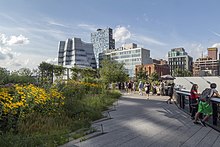User:Emuzgi/Landscape urbanism
| This is the sandbox page where you will draft your initial Wikipedia contribution.
If you're starting a new article, you can develop it here until it's ready to go live. If you're working on improvements to an existing article, copy only one section at a time of the article to this sandbox to work on, and be sure to use an edit summary linking to the article you copied from. Do not copy over the entire article. You can find additional instructions here. Remember to save your work regularly using the "Publish page" button. (It just means 'save'; it will still be in the sandbox.) You can add bold formatting to your additions to differentiate them from existing content. |
Article Draft[edit]


Landscape Urbanism and New Urbanism[edit]
Both the theories of Landscape Urbanism and New Urbanism emerged as responses to modernist architecture and planning practices[1]. Both intended to address the rigidity of the existing urban form as well as the lack of environmental consciousness informing urban design[1]. New Urbanists prioritize interconnectedness of the neighborhood through well-defined streets that generate walkability[2]. Landscape Urbanists place the importance of urban order on a “thin horizontal vegetal plane”, using the concept of green-space as the base for urban planning as opposed to the streetscape[1]. In this way, Landscape Urbanists wish to circumvent the inflexibility and “uninspired failings” of postmodern urban planning practices[1]. At its core, the theory of Landscape Urbanism addresses problems of urban sprawl, de-densification, and environmental change in what is referred to as “a disciplinary realignment… in which landscape is usurping architecture’s historical role as the basic building block of city making”[1]. It is primarily this principle that is debated between New Urbanists and Landscape Urbanists.
Projects[edit]
The following are Landscape Urbanism projects that can provide more information about the theory in practice:
- Parc de la Villette, Bernard Tschumi[3]
- Millenium Park, SOM (Park Masterplan)[3]
- Olympic Sculpture Park, Weiss/Manfredi[3]
- Klyde Warren Park, The Office of James Burnett[3]
- Madrid Rio, Ginés Garrido [Director] Burgos & Garrido / Porras La Casta / Rubio A.Sala / West 8
- Fresh Kills Landfill Competition, Field Operations/James Corner Field Operations – home
- The High Line, Field Operations/James Corner
- Downsview Park Competition, all finalist entries ::Parc Downsview Park: The Finalists::
- Schouwburgplein, Rotterdam, West 8/Adriaan Geuze
- Projects by Stoss/Chris Reed Stoss Landscape Urbanism
Criticism[edit]
Landscape Urbanism has been criticized for being only a loosely defined idea that influences flashy projects. These have been decried as expensive schemes with a commercial and aesthetic purpose that satisfy a local ambition to invest in ecology or sustainability without posing a more globally applicable approach. Some believe that these projects pander to elite patrons and academics invested in design competitions, instead of accomplishing meaningful objectives[2].
Critics also see Landscape Urbanism as falling short of a true merger of the fields of landscape architecture and Urban Ecology. From this criticism American ecologist and landscape architect Frederick Steiner introduced the theory of “landscape ecological urbanism” as an approach to better include the field of urban ecology in city planning[4]. Others have emphasized that in order to develop a new urban ecology, this type of integrative planning and management of cities should be reliant on intensive analysis of nature in an urban environment[5].
- ^ a b c d e Waldheim, Charles (2016-12-31). Landscape as Urbanism. Princeton: Princeton University Press. ISBN 978-1-4008-8054-6.
- ^ a b ), Duany, Andres. Talen, Emily, (1958- (2013). Landscape urbanism and its discontents : dissimulating the sustainable city. New Society Publishers. ISBN 978-0-86571-740-4. OCLC 883571819.
{{cite book}}:|last=has numeric name (help)CS1 maint: multiple names: authors list (link) CS1 maint: numeric names: authors list (link) - ^ a b c d "12 Projects that Explain Landscape Urbanism and How It's Changing the Face of Cities". ArchDaily. 2016-04-06. Retrieved 2021-11-23.
- ^ Steiner, Frederick (2011-04). "Landscape ecological urbanism: Origins and trajectories". Landscape and Urban Planning. 100 (4): 333–337. doi:10.1016/j.landurbplan.2011.01.020. ISSN 0169-2046.
{{cite journal}}: Check date values in:|date=(help) - ^ Kuitert, Wybe (2013-03). "The nature of urban Seoul: potential vegetation derived from the soil map". International Journal of Urban Sciences. 17 (1): 95–108. doi:10.1080/12265934.2013.766505. ISSN 1226-5934.
{{cite journal}}: Check date values in:|date=(help)
